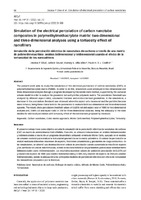Simulation of the electrical percolation of carbon nanotube composites in polymethylmethacrylate matrix: two-dimensional and three-dimensional analyses using a tortuosity effect of nanofillers
Date
2021-12-14Author
Pereira Silva, Jessica
Sousa, Lailson
Villa-Vélez, Harvey Alexander
Coelho, Paulo Henrique
Metadata
Show full item recordAbstract
The present work aims to study the simulation of the electrical percolation of carbon nanotubes (CNTs) in polymethylmethacrylate matrix (PMMA). In order to do this, simulations were employed in two-dimensional and three-dimensional analyses through a program developed by the Monte Carlo method, supported by the excluded volume model in order to analyze the geometric tortuosity in the polymeric matrix. The percolation threshold was analyzed by different aspect ratios, volumetric fractions and conductive load geometries. In the simulations, a decrease in the percolation threshold was observed when the aspect ratio increased and the particles became more tortuous, being these characteristics the parameters to evaluate both two-dimensional and three-dimensional systems. The results show percolation threshold values of 0.625% vol and aspect ratio of 1000 for two-dimensional analyses and, 0.08% vol and aspect ratio of 250 for three-dimensional analyses, being the adequacy to the main models for electrical percolation with tortuosity effect of the nanocarriers proposed by literature. El presente trabajo tiene como objetivo estudiar la simulación de la percolación eléctrica de nanotubos de carbono (CNT) en matriz de polimetilmetacrilato (PMMA). Para ello, se utilizaron simulaciones en análisis bidimensionales y tridimensionales a través de un programa desarrollado utilizando el método Monte Carlo, apoyado en el modelo de volumen excluido para analizar la tortuosidad geométrica en la matriz polimérica. El umbral de percolación se analizó mediante diferentes relaciones de aspecto, fracciones volumétricas y geometrías de carga conductiva. En las simulaciones, se observó una disminución en el umbral de percolación cuando aumentaba la relación de aspecto y las partículas se volvían más tortuosas, siendo estas características los parámetros para evaluar sistemas tanto bidimensionales como tridimensionales. Los resultados muestran valores de umbral de percolación de 0.625% vol y relación de aspecto de 1000 para análisis bidimensionales y 0.08% vol y relación de aspecto de 250 para análisis tridimensionales, siendo la adecuación a los principales modelos de percolación eléctrica con efecto de tortuosidad los nanoaditivos propuestos por la literatura.
Collections
The following license files are associated with this item:



